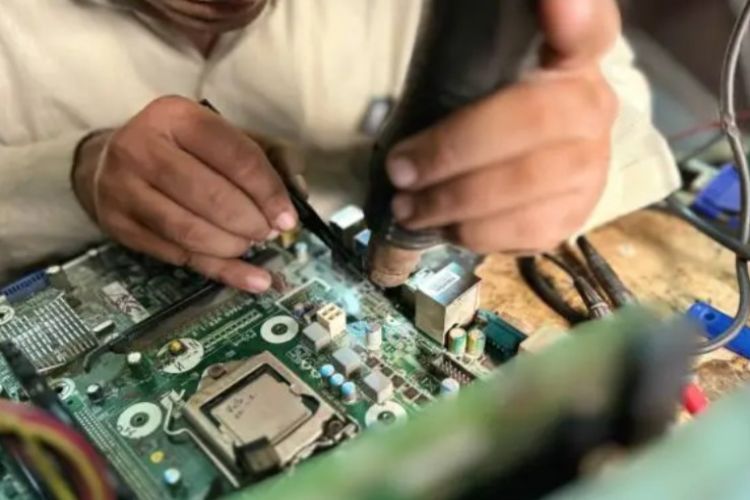
India’s announcement that it will unveil its first indigenously manufactured semiconductor chip later this year marks a milestone—symbolic and strategic—in what could become one of the country’s most significant industrial transitions in recent history. The specifications of the chip, ranging between 28 to 90 nanometres, may not rival cutting-edge global standards. But in both economic and geopolitical terms, the move is consequential. These chips will serve segments that account for nearly 60% of global semiconductor demand—automotive electronics, power systems, telecom equipment, and industrial automation. By attempting to carve a niche in this critical supply chain, India is not just manufacturing silicon; it is testing the limits of its policy ambition, industrial capacity, and strategic imagination.
What follows this rollout will matter far more than the launch itself. Unlike past industrial efforts buoyed by India’s legacy in services or low-cost labour arbitrage, this domain demands something different. It demands precision engineering, high-yield project execution, access to scarce materials, trust in global alliances, and a coherent technology doctrine. The semiconductor journey cannot be won on headlines or intent. It will be won on execution timelines, intellectual property creation, and the ability to embed India into the world’s most tightly controlled and technologically advanced supply network.
READ | World Bicycle Day: Indian cities need a cycling revolution
Strategic stakes in a fractured global order
Semiconductors have moved from being enabling technologies to strategic assets. They now lie at the heart of a growing techno-nationalist rivalry that defines global geopolitics. From the US-led export controls on advanced lithography tools to China’s acceleration of indigenous capacity, this is no longer an industry operating within the boundaries of free-market logic. India’s chip ambitions must be situated in this geopolitical context.
As the world searches for alternatives to the current few-nations concentration, India enters at a rare moment of structural fluidity. The global appetite for supply chain diversification is real. The China-plus-one strategy is driving corporate and sovereign recalibration. But the window will not remain open indefinitely. India must move from being an aspirant to a reliable manufacturer. This means not just announcing fabs but embedding itself in future trade frameworks, standard-setting platforms, and semiconductor technology alliances.
Technology diplomacy will matter as much as technology itself. Whether through bilateral frameworks like the India-US Initiative on Critical and Emerging Technology or potential chip corridors with Japan and Korea, India must earn its credibility as a strategic co-builder. Access to lithography machines from the Netherlands, specialty chemicals from Japan, and EDA software tools from the US will depend as much on geopolitical trust as on commercial contracts.
Institutions, not just infrastructure
Building fabs is only the visible tip of a much deeper iceberg. Modern semiconductor fabrication requires not only cleanroom precision but also near-flawless alignment across regulatory norms, customs efficiency, land and water provisioning, skilled labour availability, and energy reliability. None of this can be episodic. Institutional coherence will determine industrial credibility.
Most advanced players—Taiwan, South Korea, the US—spent decades nurturing an ecosystem that runs from research to materials to production to export. India, by contrast, is attempting to compress this journey into a few years. This compression comes with steep risks. Time cannot be bought. Experience cannot be rushed. While India has a rich pool of design talent and contributes to nearly a fifth of the world’s chip design workforce, this advantage cannot mask its underdeveloped capabilities in fabrication, materials, and testing.
There is also the question of state-level capacity. Semiconductor ecosystems are inherently subnational. What will determine the success of Dholera or Yadadri is not only the Centre’s incentives but how state governments deliver power, land acquisition, worker skilling, and industrial facilitation on the ground. Industrial policy cannot be centralised if execution is not.
One of India’s more realistic entry points may lie in Assembly, Testing, Marking and Packaging (ATMP) and advanced packaging, where capital requirements are lower and geopolitical barriers less sharp. This is a segment whose strategic value is growing and where India could potentially lead in a relatively short time. For this to happen, project management must match ambition, and IP development must track global evolution—not lag it.
From scheme to strategy, vision to doctrine
India’s semiconductor programme cannot remain a procurement or subsidy mission. It must evolve into a national doctrine—one that aligns industrial vision, economic security, technological autonomy, and strategic statecraft.
Semiconductors are capital-intensive and unforgiving. They demand strategic capital that is patient and disciplined. Public-private partnership models must reflect this, with a clear division of labour between the State’s role in upstream risk-sharing and the private sector’s role in downstream productivity and innovation.
India also needs to develop its domestic IP base. Without control over proprietary chip architectures, fabrication alone will not deliver self-reliance. If domestic firms fail to develop cost-effective, scale-ready, IP-protected products, the outcome may be strategic vulnerability masked as industrial progress. Reverting to imports—especially from rival states—would undercut the very rationale for building domestic capacity.
The global semiconductor race is not just a matter of economic competitiveness. It is now a litmus test of national resilience. Those who succeed will be those who integrate statecraft with precision industrial execution and fuse domestic capability with strategic alignment. India must be judged not by its announcements but by whether it becomes a trusted and indispensable part of the global semiconductor order. That bar is high. Meeting it will require an entirely new industrial pace and mindset—where the past glory of India Inc becomes less relevant than its capacity to execute with precision, create globally relevant IP, and govern with clarity across the entire semiconductor lifecycle.
India’s ambition is not misplaced. But ambition without industrial coherence, and capital without capacity, will only produce headlines without consequence. It must now prove that its semiconductor journey is institutional — that it can deliver not only chips, but confidence of the users. What India needs now is neither urgency nor euphoria but—quiet competence sustained over the next decade. Until then, it would be premature to call anything as a win.
Srinath Sridharan is a strategic counsel with 25 years experience with leading corporates across diverse sectors including automobiles, e-commerce, advertising and financial services. He understands and ideates on intersection of finance, digital, contextual-finance, consumer, mobility, Urban transformation, and ESG. Actively engaged across growth policy conversations and public policy issues.

